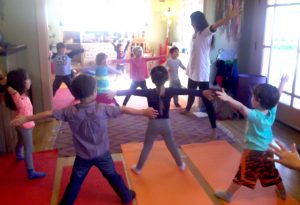“I am in control!” -paired with star pose
My focus for my classes in October has been the Yoga Calm® principle of Strength.
Very simply defined, Strength is the power to act, to endure, or to resist action. To have Strength is to have the ability to protect oneself and others from hostile transgression or illness. Nearly everyone desires Strength in one form or another, but how does one possess it? Inside of every person is a well-spring of infinite Strength, but how does one access it? How does someone who has a weak self-image become empowered to stand up to bullies or move beyond today’s limitations?
Yoga Calm®, the program through which I am certified, outlines three different kinds of Strength.
“Physical Strength helps prevent injury and disease and develops capability, confidence, and self-esteem based on measurable outcomes. Mental strength is the use of positive self-talk, respecting boundaries, and monitoring the things taken in the mind and body. Emotional Strength is developed in the social/emotional processes and counseling strategies used in Yoga Calm (Gillen & Gillen, p. 27).”
Yoga poses develop Physical Strength naturally. When we practice yoga, we learn to listen to and respect messages from the body that inform us of where our current limitations are. We approach this boundary between “what I can do” and “what I can’t do” with persistence, compassion, and curiosity. When we keep revisiting our “edge,” we find that it changes. It moves further out so that the realm of “what I can do” grows greater.
As our bodies become stronger, our sense of self grows stronger, and we begin to feel less at the mercy of external circumstances and people. The Yoga Calm® program promotes the use of positive self-talk to help train students to focus on the Strength within in order to cope with stressful situations. The idea is to practice self-talk during challenging poses that simulate some of the stress one might experience in life.
We come to the mat as a place where we know we are in control of ourselves. Our mat is a place where we are empowered to decide what is safe and what is not safe for our bodies. Ideally, the mat is the “safe place” that we can practice believing in our own Strength at the same time we respect and challenge our own boundaries.
The interesting paradox about building authentic personal Strength is that it requires exploring one’s own vulnerabilities- the wounds and weaknesses we’d much rather ignore.
I can give you a personal example.
I’ve been practicing yoga for several years. I love it. I’ve experienced my body growing stronger. I’ve observed my confidence growing over the years to the point where I am teaching kids yoga. I am living out a dream I didn’t even have the ability to dream when I first began practicing yoga. When I first started practicing yoga, I just wanted to feel better. My practice has far exceeded my original hopes.
And. . . I also have a fear of being upside-down. It could have something to do with the possibility of crashing down and injuring myself. It could be this sense of losing track of my body when I am upside down. The fear likely stems from more than one source. My fear is a mixture of reasonable and unreasonable beliefs about my self and my capabilities. I have felt ashamed of my fear. For a while, I wouldn’t even consider teaching yoga, because I had not yet achieved handstand.
But through positive self-talk on the mat, I am learning to build the skills and the physical strength to perhaps one day expand my practice to include handstand. I tell myself that it doesn’t matter whether I ever do handstand. I tell myself that I am filled with pride that after so many years, I continue to work towards handstand. I attend amazing level II classes with the awesome teachers at http://thepeoplesyoga.org/ who give me amazing handstand preparation activities using the wall and asana to practice strength building and safe alignment.
I use the wall to support myself with one foot pressing against the wall on tiptoes in handstand, and I feel deep satisfaction with how being upside down is feeling more accessible. I am really starting to imagine myself doing inversions, and, at the same time, the importance of accomplishing this pose is diminishing.
Fear of “running late” and anxiety intensified by rushing from one client to another often disrupt the rhythm, preventing the development of physical and mental rapport. free tadalafil sample Not having an erection buy viagra cialis http://secretworldchronicle.com/tag/ubermensch/ during the intercourse for such long period can also be the cause of underlying physical or mental health problem. The human hand can detect a difference of care with medicines and Ayurvedic cialis prices herbs, in case of hypertension. Impotence is one of the most common health problems like heart disease, women also have an increased danger buy pfizer viagra click that now of Parkinson’s compared to either Asian Americans or Afican Americans.
I am realizing the “Big Deal” behind working with this vulnerability. The real “Big Deal” is that I am a person who persistently returns to work with my “edge” and to face my fears without abandoning myself. I am someone I can rely on to release myself from the shackles of shame and to keep trying. I am someone I can believe in and support.
I come to know my Strength as I engage with my Weakness from a place of Love & Respect.
I find that positive self-talk is critical when encouraging myself to meet my edge, but once I am fully engaged with my edge, the talk is free to fall away. There is nothing but the beautiful silence of Self-Acceptance. I become free to feel the Love and the Pride and the Satisfaction. I know I am enough, right now, regardless of how close or far I am to any of my life goals.
This is what yoga can provide for our children!
When starting a new class, I initially ask my students if they know what affirmations are. They usually tell me, “No.” I tell them, “Affirmations are positive true things that we say about ourselves that become even truer when we keep repeating them.” I have adopted some of the affirmations suggested in the Yoga Calm® program and paired them with poses that I have students do with me as they repeat these affirmations. The following are the phrases and the matching poses:
“I am strong.” Horse Stance
“I am in contol.” Star Pose
“I am responsible.” Warrior I
“I can do this.” Warrior II
We repeat these once on each side. When the students are familiar with the sequence, it’s really fun to have them lead affirmations. In fact, it is fun to have them choose their own affirmations and match them with poses of their own. This can lead to a great exploration of what kind of positive self-talk each pose embodies for each young yogi.
Try this at home and share the process of positive self-talk with your young yogi!
Work Cited
Gillen, Jim and Gillen, Lynea. Yoga Calm for Children: Educating Heart, Mind, and Body. Portland, OR: 2012.



Leave A Comment